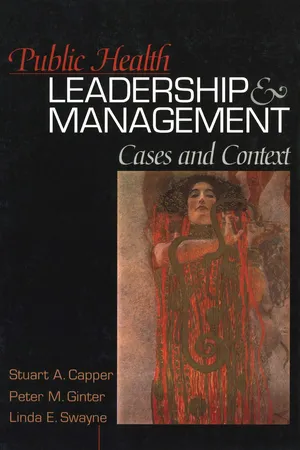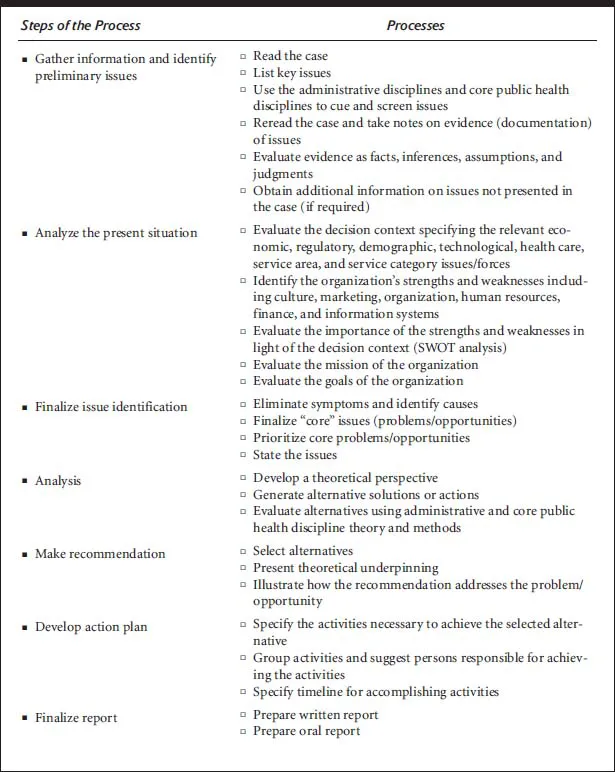
eBook - ePub
Public Health Leadership and Management
Cases and Context
This is a test
- 408 pages
- English
- ePUB (mobile friendly)
- Available on iOS & Android
eBook - ePub
Public Health Leadership and Management
Cases and Context
Book details
Book preview
Table of contents
Citations
About This Book
The six chapters and fifteen cases contained in this book challenge students to ask the appropriate questions and stimulate their thinking about public health leadership and management. The situations presented by each case are vivid and provide not only a basis for practicing professional public health judgements but also provide a lasting impression that aids in retention of the lessons learned.
Frequently asked questions
At the moment all of our mobile-responsive ePub books are available to download via the app. Most of our PDFs are also available to download and we're working on making the final remaining ones downloadable now. Learn more here.
Both plans give you full access to the library and all of Perlego’s features. The only differences are the price and subscription period: With the annual plan you’ll save around 30% compared to 12 months on the monthly plan.
We are an online textbook subscription service, where you can get access to an entire online library for less than the price of a single book per month. With over 1 million books across 1000+ topics, we’ve got you covered! Learn more here.
Look out for the read-aloud symbol on your next book to see if you can listen to it. The read-aloud tool reads text aloud for you, highlighting the text as it is being read. You can pause it, speed it up and slow it down. Learn more here.
Yes, you can access Public Health Leadership and Management by Stuart A. Capper, Peter M. Ginter, Linda E. Swayne in PDF and/or ePUB format, as well as other popular books in Médecine & Santé publique, administration et soins. We have over one million books available in our catalogue for you to explore.
Information
PART I
Improving Public Health Leadership and Management
Part I contains four chapters that provide tools for decision making and case analysis. The first chapter presents a process for addressing and solving public health case studies. It provides a broad template for thinking through and making decisions in complex public health situations. Chapter 2 presents a valuable list of sources for public health information including abstracts, electronic information sources, dictionaries, directories, handbooks and guides, journals, and Internet public health resources. These information sources are essential for the public health practitioner addressing actual public health issues and for the case analyst searching for additional case information. Chapter 3 provides recommendations for making effective oral presentations. These presentation suggestions are appropriate for both classroom presentations and presentations required in public health practice. The last chapter presents a brief primer on health care finance. The primer is designed to provide a broad view of health care finance that may be applied to a variety of health care and public health situations.
| CHAPTER 1 |
Analyzing Public Health Cases
Public health management and leadership roles often call for far-reaching decisions that will affect the health of a community. Decisions must be made despite conflicting data, divergent opinions, and competing political agendas. Therefore, public health management and leadership require an understanding of current and emerging community health issues as well as the agency’s resources and capabilities. In addition, in making these decisions, public health managers and leaders must understand public health practice and science. Public health management and leadership decisions typically require simultaneously balancing community issues, organizational issues, and public health science. In this complex decision environment, there are many competing issues, and public health science informs the judgment—it does not make the decision.
How does a leader and manager learn to make decisions in public health organizations? The most valuable way is to practice making decisions. The public’s health may suffer until a leader develops his or her skills by on-the-job trial and error. Another way to acquire experience is to observe the decision making of others. Unfortunately, learning by observing others is not practical in most rapidly changing environments, nor is it practical in the often unique situations that public health leaders face.
Even if trial-and-error learning or learning by observation were feasible, it would be very risky; therefore, public health organizations, hospitals, and other health providers would trust important decision making only to the most “seasoned managers.” As a result, case studies have been used successfully to provide aspiring leaders with the opportunity to practice making decisions without “betting the organization” and the public’s health on the outcome. In other words, case studies offer an opportunity to deal with real decisions in a low-risk environment.
The case studies presented in this book contain situations actually faced by managers and leaders in public health organizations and are documented in a way that makes them useful in educating decision makers. The decisions required to solve these cases represent a wide range of complexity, so that no two cases are addressed in exactly the same manner. In the following discussion, one method of case analysis is presented. This approach is useful because it is a logical method of decision making. Exhibit 1.1 offers a process or way of thinking about cases rather than prescribing the only way to analyze them.
First, it is important to gather information and identify the issues. Often, there will be many issues in a case that eventually will lead to defining the problem or identifying an opportunity. Identifying as many of the issues as possible is critical to understanding the problem clearly. Ultimately, the decision maker may not be able to deal with every issue. However, knowing the issues and being able to prioritize them is fundamental to defining the problem and crafting a decision. Information in the case may or may not be useful. Part of the process of identifying issues is to evaluate the information and differentiate between factual information, inferential information, speculations, and assumptions.
Second, it is important to understand the decision context or external forces that may affect public health—the political/legal, economic, social/cultural, technological, competitive, and health issues that public health leaders face. These forces represent the context that frames the decision. At this point, relating the capabilities of the organization to the decision context becomes important. To do this, a thorough and objective analysis of the organization’s internal strengths and weaknesses is re-quired. One of the most useful ways to look introspectively at a public health organization is to examine its resource base and the capabilities possessed by its professional and nonprofessional employees. In addition, it is necessary to understand the unique culture of the organization, including its mission and goals.
Once the situation analysis is complete—examining the decision context, the organization, and the organization’s mission and goals—the problem or opportunity should be identified and alternatives generated as possible solutions. At least some thought must be given to the outcomes likely to result from the different choices. The effectiveness of the various alternatives must be evaluated. Then one of the alternatives needs to be chosen to become the recommendation and its method of implementation considered.
Although the approach outlined here is logical, it is important to remember that a case should be approached and appreciated as a unique opportunity for problem solving. The organization, context, and decision make each case different.
Cases: Real and Hypothetical
Many different types of cases are used for public health leadership and management education. Sometimes cases are invented to illustrate a specific point. Usually these appear as “ABC Public Health Department” or some similar name. Other cases are real but disguised. A writer may, for example, have information from an organization such as the Veterans Administration or Medicaid in Illinois but for some reason have been asked not to use the name of the organization.
| Exhibit 1.1. | Process of Analysis for Public Health Cases |

The best cases, like those in this book, are real and undisguised. Cases such as “CDC and the Mantookan Blood Supply” and “The Indiana State Department of Public Health” are obviously about real organizations. The cases in this book have been selected because of the important issues they present for public health leaders. Sometimes the issues presented are not even problems. Often the greatest challenge facing an organization is recognizing and acting on an opportunity rather than solving a problem.
Cases that have obvious solutions that everyone agrees with are not good for practicing decision making. Leaders in public health organizations rarely face decisions where the solution is obvious to everyone. Real life is quite complex, and so are most cases. For example, public health science may be in conflict with political realities, economic issues may be at odds with social issues or priorities, and optimal alternatives may not be feasible. Although there is seldom a single correct answer in case analysis, some recommendations clearly are better than are others. The evaluation of a case analysis is often based more on the approach and logic employed than the precise recommendation offered. This often mirrors the way a choice by a public health decision maker will be evaluated in the practice setting. Because difficult judgments are often required, and because there will be no absolutely correct or incorrect decision, constituents may evaluate the decision of the public health leader based on his or her logic and approach rather than the specific decision. As long as the decision is rational in the context of the community, the logic and approach used by the public health leader to reach the decision often will form the foundation of the leader’s credibility and the basis for the community’s acceptance of the decision.
Cases, Management, and Public Health
Cases offer practice in decision making that is impossible to achieve through other means. Cases rarely give us all the information we need; decision makers in public health organizations rarely have all the information they want or need when they face decisions. Risks must be taken in real-life decision making, and a good case analysis will involve similar types of risks. A poor case analysis may be embarrassing for the student, but it will not result in unnecessary health risks, poor policy decisions, misinterpretation of science, or declining health status for a community. At the same time, the lessons learned by analyzing cases and participating in discussions will build problem-solving skills.
Many future public health decision makers are not familiar with how to analyze cases. For this reason, this chapter has been included—not to prescribe how all cases should be solved but to offer some initial direction on how to “surface”the real issues presented in the cases and carry out logical analysis.
Solving Case Problems
Solving a case is much like solving any problem. First, the issues are defined, information is gathered, and alternatives are generated, evaluated, recommended, and implemented. Although the person solving one of the cases from this book seldom has the opportunity to implement a decision, he or she should always keep in mind that recommendations must be tempered by the limitations imposed on the organization in terms of its human and nonhuman resources. As the likely success or failure of the recommendation is analyzed and discussed, lessons are learned that can be applied to future decision making.
Alternative Perspectives: Passion or Objectivity
Public health management and leadership cases have to do with people in organizations trying to make decisions in the face of uncertainty. Therefore, the key decision maker and the organization must be identified. Public health is an organized effort to create healthy people in...
Table of contents
- Cover page
- Title
- Copyright
- Contents
- Foreword
- Preface
- Part I: Improving Public Health Leadership and Management
- Part II: Public Health—Context
- Part III: Public Health—Cases
- Index
- About the Authors